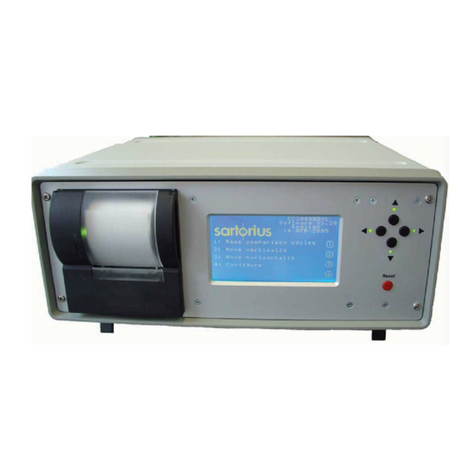
List of Contents PR 5610 Installation Manual
2 Sartorius
4.1.4 Cold / Warm start ....................................................................................................................................... 58
4.2 DISPLAY ELEMENTS AND CONTROLS..................................................................................................................... 59
4.2.1 Control signals............................................................................................................................................ 59
4.2.2 Language .................................................................................................................................................... 59
4.2.3 Operating concept ‘Commissioning’.......................................................................................................... 60
4.3 MAIN MENU.......................................................................................................................................................... 61
4.3.1 Function setup ............................................................................................................................................ 61
4.3.2 Boot menu................................................................................................................................................... 65
4.4 WEIGHING POINT ASSIGNMENT............................................................................................................................. 69
4.4.1 Error messages on the weight display........................................................................................................ 70
4.4.2 W&M Parameter......................................................................................................................................... 71
4.5 CALIBRATION, INTERNAL ADC............................................................................................................................ 72
4.5.1 Calibration sequence.................................................................................................................................. 72
4.5.2 Error messages at calibration start............................................................................................................ 72
4.5.3 Calibration / Configuration counters......................................................................................................... 72
4.5.4 Select weighing point.................................................................................................................................. 73
4.5.5 Display calibration data............................................................................................................................. 73
4.5.6 Select calibration mode .............................................................................................................................. 73
4.5.7 Set full scale................................................................................................................................................ 74
4.5.8 Set step width.............................................................................................................................................. 74
4.5.9 Set dead load ..............................................................................................................................................74
4.5.10 Set full scale deflection (span).................................................................................................................... 75
4.5.11 Calculate test value..................................................................................................................................... 76
4.5.12 Exit calibration........................................................................................................................................... 77
4.5.13 Set parameters............................................................................................................................................ 78
4.6 CONFIGURATION FOR 'LIQUID', 'USER', 'GWT-SCALE', 'XBPI-SCALE'................................................................... 80
4.6.1 Weighing point function liquid counter...................................................................................................... 80
4.6.2 Weighing point function GWT-scale........................................................................................................... 81
4.6.3 Weighing point function User-scale ........................................................................................................... 81
4.6.4 Weighing point function xBPI-scale........................................................................................................... 82
4.7 XBPI SCALE......................................................................................................................................................... 83
4.7.1 xBPI Serial port setup................................................................................................................................. 84
4.7.2 xBPI Weighing point assignment and configuration.................................................................................. 84
4.7.3 xBPI Platform configuration ...................................................................................................................... 85
4.7.4 xBPI Scale parameters ............................................................................................................................... 86
4.7.5 xBPI Scale parameter tables....................................................................................................................... 87
4.7.6 xBPI Scale setting deadload....................................................................................................................... 89
4.7.7 xBPI Scale error message........................................................................................................................... 89
4.7.8 xBPI Calibration with internal weight........................................................................................................ 90
4.7.9 xBPI Calibration with user weight ............................................................................................................. 90
4.7.10 xBPI Calibration with automatic weight recognition................................................................................. 91
4.7.11 xBPI Calibration with preset weight........................................................................................................... 91
4.8 CONFIGURATION OF NON-WEIGHING POINT RELATED PARAMETERS ..................................................................... 92
4.8.1 Set clock (date and time)............................................................................................................................. 92
4.8.2 Serial ports ................................................................................................................................................. 92
4.8.3 Software parameters................................................................................................................................... 94
4.8.4 Fieldbus parameter..................................................................................................................................... 96
4.8.5 Licence setup .............................................................................................................................................. 97
4.8.6 Show board number.................................................................................................................................... 98
4.8.7 Print setup data........................................................................................................................................... 98
4.8.8 Last fault..................................................................................................................................................... 98
4.8.9 Refresh display............................................................................................................................................ 98
4.8.10 I/O Slots ...................................................................................................................................................... 99
4.8.11 Show Version.............................................................................................................................................. 99
4.8.12 Enable download...................................................................................................................................... 100
4.8.13 Reboot....................................................................................................................................................... 100
4.9 CONFIG PROGRAM FOR APPLICATION PARAMETERS............................................................................................ 100
4.10 MODBUS / J-BUS PROTOCOL.......................................................................................................................... 101
4.10.1 Communication......................................................................................................................................... 101
4.10.2 Function 1 or 2: Read n bits..................................................................................................................... 102
4.10.3 Function 3 or 4: Read n successive words ............................................................................................... 102
4.10.4 Function 5: Write a bit ............................................................................................................................. 103




























